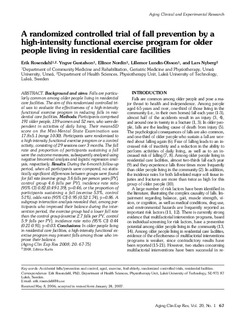| dc.contributor.author | Rosendahl, Erik | |
| dc.contributor.author | Gustafson, Yngve | |
| dc.contributor.author | Nordin, Ellinor | |
| dc.contributor.author | Lundin-Olsson, Lillemor | |
| dc.contributor.author | Nyberg, Lars | |
| dc.date.accessioned | 2017-06-07T12:40:06Z | |
| dc.date.available | 2017-06-07T12:40:06Z | |
| dc.date.issued | 2008 | |
| dc.identifier.citation | Rosendahl, E., Gustafson, Y., Nordin, E., Lundin-Olsson, L., & Nyberg, L. (2008). A randomized controlled trial of fall prevention by a high-intensity functional exercise program for older people living in residential care facilities. Aging clinical and experimental research, 20(1), 67-75 | |
| dc.identifier.uri | http://hdl.handle.net/11250/2445139 | |
| dc.description | Artikkelen omhandler en randomisert kontrollert studie hvor hensikten var å vurdere om et høyintensivt fysisk treningsprogram har effekt på fall hos eldre mennesker bosatt i institusjon. | |
| dc.description.abstract | BACKGROUND AND AIMS: falls are particularly common among older people living in residential care facilities. The aim of this randomized controlled trial was to evaluate the effectiveness of a high-intensity functional exercise program in reducing falls in residential care facilities. METHODS: participants comprised 191 older people, 139 women and 52 men, who were dependent in activities of daily living. Their mean+/-SD score on the Mini-Mental State Examination was 17.8+/-5.1 (range 10-30). Participants were randomized to a high-intensity functional exercise program or a control activity, consisting of 29 sessions over 3 months. The fall rate and proportion of participants sustaining a fall were the outcome measures, subsequently analysed using negative binominal analysis and logistic regression analysis, respectively. RESULTS: during the 6-month follow-up period, when all participants were compared, no statistically significant differences between groups were found for fall rate (exercise group 3.6 falls per person years [PY], control group 4.6 falls per PY), incidence rate ratio (95% CI) 0.82 (0.49-1.39), p=0.46, or the proportion of participants sustaining a fall (exercise 53%, control 51%), odds ratio (95% CI) 0.95 (0.52-1.74), p=0.86. A subgroup interaction analysis revealed that, among participants who improved their balance during the intervention period, the exercise group had a lower fall rate than the control group (exercise 2.7 falls per PY, control 5.9 falls per PY), incidence rate ratio (95% CI) 0.44 (0.21-0.91), p=0.03. CONCLUSIONS: in older people living in residential care facilities, a high-intensity functional exercise program may prevent falls among those who improve their balance. | |
| dc.language.iso | eng | |
| dc.subject | Sverige | |
| dc.title | A randomized controlled trial of fall prevention by a high-intensity functional exercise program for older people living in residential care facilities | |
| dc.type | Journal article | |
| dc.type | Peer reviewed | |
| dc.rights.holder | Erik Rosendahl | |
| dc.source.volume | 10 | |
| dc.source.journal | Aging Clinical and Experimental Research | |
| dc.source.issue | 1 | |
| dc.identifier.doi | https://doi.org/10.1007/BF03324750 | |
| dc.description.localcode | måsjekkes | |
